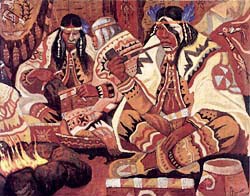Extracts from Maliseet &Mi’kmaq:
First Nations of the Maritimes by Robert Leavitt
Spiritual leaders and authorities in Aboriginal Communities
A puion (Mi'kmaq) or motewolon (Maliseet) was a man or woman who had power to communicate with the unseen world.
Puoins usually carried a medicine bag containing bones, pebbles, carved figures and other sacred objects that helped them use their extraordinary powers. They could locate game and fish, forecast the weather, and know what other powerful beings were doing. fulfil both governmental and spiritual responsibilities.
Today the captains of the Grand Council represent individual Mi'kmaq communities, rather than the larger districts. Not all communities have active captains, but in recent years participation has been increasing.

With medicines and ceremonies, they could cure an illness or remedy harm that those other powers caused. People in the community respected puoins, motewolons and kinaps/ginaps and gave them gifts for their help.
Boys and girls who showed signs of having unusual powers might be sent to live with a puoin, motewolon or kinap/ginap to be educated
A kinap or ginap (GEE-nahb; literally "great man") is a person who has extraordinary strength or skill. When there was a conflict with a neighbouring people, the kinaps/ginaps would advise the community and lead raids.
The Mi'kmaqs and Maliseets probably did not engage in actual wars, but may have feuded with people who had insulted or injured a relative or friend. Later, kinaps/ginaps were called captains.
A saqamaw (ZAH-h'm-ow; Mi'kmaq) or sakom (ZAH-g'm; Maliseet) was a highly respected man in the community, whose advice people valued. Today these words mean "chief", and the first European visitors often described saqamaws as "kings" and thought of them as commanders.
In ancient times, however, Mi'kmaq leaders were members of the community who had gained influence and respect, not power. They could not tell people what to do.
The Europeans thought that the son of a saqamaw or sakom would automatically become a chief himself if he had the ability.
Actually, a young man living in a chief's household would be likely to have the required qualities, but he might not be the chief's own son. The chief would have called many young men "son"- his own sons, his brothers' sons, the sons of his male first cousins, and his adopted sons.
Political and spiritual leadership
For the Mi'kmaq people, government, politics, economy and spirituality are all united. Therefore, the Grand Council has responsibility for the spiritual well-being of the Mi'kmaq people.
Many of these spiritual responsibilities are connected with the practice of Roman Catholicism among the Mi'kmaqs, including, for example, the celebrations at Chapel Island on the Feast of St. Ann each July.
In fact, since 1610, when Grand Chief Membertou was baptized at Port Royal by Father Jesse Fleche, the Mi'kmaq Nation has had a special relationship with the Church. This relationship was spelled out in a concordat, or treaty, between the Grand Council and the Pope, in which the Mi'kmaqs agreed to protect priests and French Catholic settlers and the Church granted certain religious authority to the Mi'kmaq Nation.
Because an agreement of this kind is only signed by a national government, the Concordat affirmed Mi'kmaq sovereignty, and Roman Catholicism became the Mi'kmaq state religion.
The Concordat was recorded on a great wampum belt. On it, the Church is represented by crossed keys (the symbol of the Holy See), a church, and a line from the Gospels written in Mi'kmaq hieroglyphics.
The Grand Council is represented by crossed lances, and armed captain, a pipe and arrow, and seven hills (symbolizing the seven districts of Mi'kmaq territory). In the centre of the belt there is a picture of a chief and a priest holding a cross together; the chief has a Bible in his hand.

The traditional aboriginal government of the Mi'kmaq Nation is known as the Grand Council. It unites the seven districts of Mi'gmagig (meeg-MAH-geeg; Mi'kmaq territory), which includes the Gaspe peninsula of Quebec, northern and eastern New Brunswick, all of Nova Scotia and Prince Edward Island and the island of Newfoundland.
Historically, the government consisted of local chiefs, selected according to clans (extended family groups) living within each district.
These leaders in turn elected a captain, or district chief, who represented the entire district at the Grand Council- known in Mi'kmaq as the Sante' Mawiomi (zahn-TEH- mah wee-OH-mee; literally "holy gathering").
The Grand Council advised the Mi'kmaq people and defended the national territory.
There are three leadership positions on the Grand Council: the Grand Chief or head of state, the Grand Captain or head of the council and the Putu's (boo-DOOZ) or wampum-reader, who guards the laws of the nation and remembers treaties entered into with other nations.
In addition, a smagn'ss (z'-MAH-g'-n'ss; literally, "soldier" or "shield-bearer") serves as protector of the people. The local chiefships and the Grand Chiefship were hereditary within one family or clan of the Mi'kmaqs. Another person might be elected if no one within the family considered himself a suitable candidate.
The traditional government and these leadership positions have continued to exist, and the Grand Council fulfil both governmental and spiritual responsibilities.
Today the captains of the Grand Council represent individual Mi'kmaq communities, rather than the larger districts. Not all communities have active captains, but in recent years participation has been increasing.
